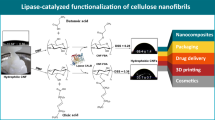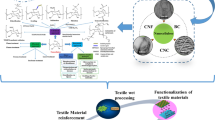Abstract
Bacterial cellulose nanocrystal (BCNC) was prepared from bacterial cellulose (BC) using acid hydrolysis for 12, 24 and 72 h. The effect of the BCNC was estimated as a means of reinforcing the poly(vinyl alcohol) (PVA) matrix in terms of mechanical and thermal properties. The effect of the hydrolysis time on BCNC extraction was evaluated by considering morphology, changes in chemical functional groups, crystallinity and thermal stability. Atomic force microscopy (AFM) images revealed the diameters of spherical cellulosic particles were in the range 16–35 nm with the smaller ones resulting from a longer hydrolysis treatment time. Fourier transform infrared (FTIR) spectroscopy showed no changes in the functional groups between BC and BCNC samples for all hydrolysis extraction times. However, X-ray diffraction (XRD) proved that the crystallinity of the BCNC increased up to 87% in comparison with the BC. The thermal stability of nanocellulose decreased over a longer hydrolysis period. Furthermore, the BCNC showed an improved effect on the PVA matrix in both tensile and thermal analysis. Therefore, BCNC obtained by acid hydrolysis for 24 h could be used as a reinforcing agent for material industries.








Similar content being viewed by others
References
Klemm D, Heublein B, Fink H-P, Bohn A (2005) Cellulose: fascinating biopolymer and sustainable raw material. Angew Chem Int Ed 44(22):3358–3393. doi:10.1002/anie.200460587
Habibi Y, Lucia LA, Rojas OJ (2010) Cellulose nanocrystals: chemistry, self-assembly, and applications. Chem Rev 110(6):3479–3500. doi:10.1021/cr900339w
Chen X, Yu J, Zhang Z, Lu C (2011) Study on structure and thermal stability properties of cellulose fibers from rice straw. Carbohydr Polym 85(1):245–250. doi:10.1016/j.carbpol.2011.02.022
Horn SJ, Nguyen QD, Westereng B, Nilsen PJ, Eijsink VGH (2011) Screening of steam explosion conditions for glucose production from non-impregnated wheat straw. Biomass Bioenergy 35(12):4879–4886. doi:10.1016/j.biombioe.2011.10.013
Teixeira EM, Corrêa AC, Manzoli A, Fabio dLL, Cauê Ribeiro dO, Mattoso LHC (2010) Cellulose nanofibers from white and naturally colored cotton fibers. Cellulose 17(3):595–606. doi:10.1007/s10570-010-9403-0
Thygesen A, Oddershede J, Lilholt H, Thomsen AB, Stahl K (2005) On the determination of crystallinity and cellulose content in plant fibres. Cellulose 12(6):563–576. doi:10.1007/s10570-005-9001-8
Klemm D, Kramer F, Moritz S, Lindstrom T, Ankerfors M, Gray D, Dorris A (2011) Nanocelluloses: a new family of nature-based materials. Angew Chem, Int Ed Engl 50(24):5438–5466. doi:10.1002/anie.201001273
Yamanaka S, Watanabe K, Kitamura N, Iguchi M, Mitsuhashi S, Nishi Y, Uryu M (1989) The structure and mechanical properties of sheets prepared from bacterial cellulose. J Mater Sci 24(9):3141–3145. doi:10.1007/bf01139032
Iguchi M, Yamanaka S, Budhiono A (2000) Bacterial cellulose—a masterpiece of nature's arts. J Mater Sci 35(2):261–270. doi:10.1023/A:1004775229149
Wan Y, Hong L, Jia S, Huang Y, Zhu Y, Wang Y, Jiang H (2006) Synthesis and characterization of hydroxyapatite–bacterial cellulose nanocomposites. Compos Sci Technol 66(11–12):1825–1832. doi:10.1016/j.compscitech.2005.11.027
Ha EYW, Landi CD (1998) Steam explosion treatment of cellulose source, extraction to remove hemicellulose and lignin. US5769934 A
Gindl W, Keckes J (2004) Tensile properties of cellulose acetate butyrate composites reinforced with bacterial cellulose. Compos Sci Technol 64(15):2407–2413. doi:10.1016/j.compscitech.2004.05.001
Millon LE, Wan WK (2006) The polyvinyl alcohol–bacterial cellulose system as a new nanocomposite for biomedical applications. J Biomed Mater Res, Part B 79B(2):245–253. doi:10.1002/jbm.b.30535
Park W-I, Kang M, Kim H-S, Jin H-J (2007) Electrospinning of poly(ethylene oxide) with bacterial cellulose whiskers. Macromol Symp 249-250(1):289–294. doi:10.1002/masy.200750347
Svensson A, Nicklasson E, Harrah T, Panilaitis B, Kaplan DL, Brittberg M, Gatenholm P (2005) Bacterial cellulose as a potential scaffold for tissue engineering of cartilage. Biomaterials 26(4):419–431. doi:10.1016/j.biomaterials.2004.02.049
Moon RJ, Martini A, Nairn J, Simonsen J, Youngblood J (2011) Cellulose nanomaterials review: structure, properties and nanocomposites. Chem Soc Rev 40:3941–3994. doi:10.1039/c0cs00108b
Ranby BG (1949) Aqueous colloidal solutions of cellulose micelles. Acta Chem Scand 3:649–650
Lu P, Hsieh Y-L (2010) Preparation and properties of cellulose nanocrystals: rods, spheres, and network. Carbohydr Polym 82(2):329–336. doi:10.1016/j.carbpol.2010.04.073
Wang N, Ding E, Cheng R (2007) Thermal degradation behaviors of spherical cellulose nanocrystals with sulfate groups. Polymer 48(12):3486–3493. doi:10.1016/j.polymer.2007.03.062
Wang N, Ding E, Cheng R (2008) Preparation and liquid crystalline properties of spherical cellulose nanocrystals. Langmuir 24(1):5–8. doi:10.1021/la702923w
Olsson RT, Kraemer R, López-Rubio A, Torres-Giner S, Ocio MJ, JMa L (2010) Extraction of microfibrils from bacterial cellulose networks for electrospinning of anisotropic biohybrid fiber yarns. Macromolecules 43(9):4201–4209. doi:10.1021/ma100217q
Martínez-Sanz M, Lopez-Rubio A, Lagaron JM (2011) Optimization of the nanofabrication by acid hydrolysis of bacterial cellulose nanowhiskers. Carbohydr Polym 85(1):228–236. doi:10.1016/j.carbpol.2011.02.021
Eichhorn SJ, Dufresne A, Aranguren M, Marcovich NE, Capadona JR, Rowan SJ, Weder C, Thielemans W, Roman M, Renneckar S, Gindl W, Veigel S, Keckes J, Yano H, Abe K, Nogi M, Nakagaito AN, Mangalam A, Simonsen J, Benight AS, Bismarck A, Berglund LA, Peijs T (2010) Review: current international research into cellulose nanofibres and nanocomposites. J Mater Sci 45(1):1–33. doi:10.1007/s10853-009-3874-0
Hamad W (2006) On the development and applications of cellulosic nanofibrillar and nanocrystalline materials. Can J Chem Eng 84(5):513–519. doi:10.1002/cjce.5450840501
Siqueira G, Bras J, Dufresne A (2010) Cellulosic bionanocomposites: a review of preparation, properties and applications. Polymers 2(4):728–765. doi:10.3390/polym2040728
Visakh PM, Thomas S (2010) Preparation of bionanomaterials and their polymer nanocomposites from waste and biomass. Waste Biomass Valori 1(1):121–134. doi:10.1007/s12649-010-9009-7
Favier V, Canova GR, Cavaillé JY, Chanzy H, Dufresne A, Gauthier C (1995) Nanocomposite materials from latex and cellulose whiskers. Polym Adv Technol 6(5):351–355. doi:10.1002/pat.1995.220060514
Kvien I, Sugiyama J, Votrubec M, Oksman K (2007) Characterization of starch based nanocomposites. J Mater Sci 42(19):8163–8171. doi:10.1007/s10853-007-1699-2
Peresin MS, Habibi Y, Zoppe JO, Pawlak JJ, Rojas OJ (2010) Nanofiber composites of polyvinyl alcohol and cellulose nanocrystals: manufacture and characterization. Biomacromolecules 11(3):674–681. doi:10.1021/bm901254n
Xu X, Yang YQ, Xing YY, Yang JF, Wang SF (2013) Properties of novel polyvinyl alcohol/cellulose nanocrystals/silver nanoparticles blend membranes. Carbohydr Polym 98(2):1573–1577. doi:10.1016/j.carbpol.2013.07.065
Voronova MI, Surov OV, Guseinov SS, Barannikov VP, Zakharov AG (2015) Thermal stability of polyvinyl alcohol/nanocrystalline cellulose composites. Carbohydr Polym 130:440–447. doi:10.1016/j.carbpol.2015.05.032
Duman O, Tunç S, Çetinkaya A (2012) Electrokinetic and rheological properties of kaolinite in poly(diallyldimethylammonium chloride), poly(sodium 4-styrene sulfonate) and poly(vinyl alcohol) solutions. Colloid Surf A 394:23–32. doi:10.1016/j.colsurfa.2011.11.018
Segal L, Creely J, Martin AJ, Conrad C (1962) An empirical method for estimating the degree of crystallinity of native cellulose using the x-ray diffractometer. Text Res J 29:786–794
Tunç S, Duman O (2011) Preparation of active antimicrobial methyl cellulose/carvacrol/montmorillonite nanocomposite films and investigation of carvacrol release. LWT Food Sci Technol 44(2):465–472. doi:10.1016/j.lwt.2010.08.018
Araki J, Wada M, Kuga S (2001) Steric stabilization of a cellulose microcrystal suspension by poly(ethylene glycol) grafting. Langmuir 17(1):21–27. doi:10.1021/la001070m
Mandal A, Chakrabarty D (2011) Isolation of nanocellulose from waste sugarcane bagasse (SCB) and its characterization. Carbohydr Polym 86(3):1291–1299. doi:10.1016/j.carbpol.2011.06.030
De Souza Lima MM, Wong JT, Paillet M, Borsali R, Pecora R (2003) Translational and rotational dynamics of rodlike cellulose whiskers. Langmuir 19(1):24–29. doi:10.1021/la020475z
Johar N, Ahmad I, Dufresne A (2012) Extraction, preparation and characterization of cellulose fibres and nanocrystals from rice husk. Ind Crop Prod 37(1):93–99. doi:10.1016/j.indcrop.2011.12.016
Wan YZ, Luo H, He F, Liang H, Huang Y, Li XL (2009) Mechanical, moisture absorption, and biodegradation behaviours of bacterial cellulose fibre-reinforced starch biocomposites. Compos Sci Technol 69(7–8):1212–1217. doi:10.1016/j.compscitech.2009.02.024
Neto WPF, Silvério HA, Dantas NO, Pasquini D (2013) Extraction and characterization of cellulose nanocrystals from agro-industrial residue – soy hulls. Ind Crop Prod 42:480–488. doi:10.1016/j.indcrop.2012.06.041
Sriupayo J, Supaphol P, Blackwell J, Rujiravanit R (2005) Preparation and characterization of α-chitin whisker-reinforced poly(vinyl alcohol) nanocomposite films with or without heat treatment. Polymer 46(15):5637–5644. doi:10.1016/j.polymer.2005.04.069
Moharram MA, Mahmoud OM (2007) X-ray diffraction methods in the study of the effect of microwave heating on the transformation of cellulose I into cellulose II during mercerization. J Appl Polym Sci 105(5):2978–2983. doi:10.1002/app.26580
Roman M, Winter WT (2004) Effect of sulfate groups from sulfuric acid hydrolysis on the thermal degradation behavior of bacterial cellulose. Biomacromolecules 5(5):1671–1677. doi:10.1021/bm034519+
Martinez-Sanz M, Lopez-Rubio A, Lagaron JM (2013) High-barrier coated bacterial cellulose nanowhiskers films with reduced moisture sensitivity. Carbohydr Polym 98(1):1072–1082. doi:10.1016/j.carbpol.2013.07.020
Pääkkö M, Ankerfors M, Kosonen H, Nykänen A, Ahola S, Österberg M, Ruokolainen J, Laine J, Larsson PT, Ikkala O, Lindström T (2007) Enzymatic hydrolysis combined with mechanical shearing and high-pressure homogenization for nanoscale cellulose fibrils and strong gels. Biomacromolecules 8(6):1934–1941. doi:10.1021/bm061215p
Lu J, Askeland P, Drzal LT (2008) Surface modification of microfibrillated cellulose for epoxy composite applications. Polymer 49(5):1285–1296. doi:10.1016/j.polymer.2008.01.028
Ten E, Turtle J, Bahr D, Jiang L, Wolcott M (2010) Thermal and mechanical properties of poly(3-hydroxybutyrate-co-3-hydroxyvalerate)/cellulose nanowhiskers composites. Polymer 51(12):2652–2660. doi:10.1016/j.polymer.2010.04.007
Lu J, Wang T, Drzal LT (2008) Preparation and properties of microfibrillated cellulose polyvinyl alcohol composite materials. Compos Part A 39(5):738–746. doi:10.1016/j.compositesa.2008.02.003
Li W, Yue J, Liu S (2012) Preparation of nanocrystalline cellulose via ultrasound and its reinforcement capability for poly(vinyl alcohol) composites. Ultrason Sonochem 19(3):479–485. doi:10.1016/j.ultsonch.2011.11.007
Fortunati E, Luzi F, Puglia D, Terenzi A, Vercellino M, Visai L, Santulli C, Torre L, Kenny JM (2013) Ternary PVA nanocomposites containing cellulose nanocrystals from different sources and silver particles: part II. Carbohydr Polym 97(2):837–848. doi:10.1016/j.carbpol.2013.05.015
Cho M-J, Park B-D (2011) Tensile and thermal properties of nanocellulose-reinforced poly(vinyl alcohol) nanocomposites. J Ind Eng Chem 17(1):36–40. doi:10.1016/j.jiec.2010.10.006
Acknowledgements
The authors are grateful to the Department of Biotechnology, Faculty of Agro-Industry, Kasetsart University, Bangkok and to Kasetsart University, Thailand for supplying facilities and to the Scholarship Program for International Graduate Students 2014.
Author information
Authors and Affiliations
Corresponding author
Rights and permissions
About this article
Cite this article
Lam, N.T., Saewong, W. & Sukyai, P. Effect of varying hydrolysis time on extraction of spherical bacterial cellulose nanocrystals as a reinforcing agent for poly(vinyl alcohol) composites. J Polym Res 24, 71 (2017). https://doi.org/10.1007/s10965-017-1232-5
Received:
Accepted:
Published:
DOI: https://doi.org/10.1007/s10965-017-1232-5




